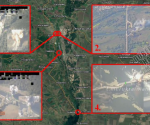Iranian humiliation of British Government, and pressure to break the will for American sanctions
The timing was impeccable. At around the same general time as Iranian TV had pictures of a vessel being seized by the Iranian Islamic Revolutionary Guard Corps (IRGC) – an operation executed back on Sunday 14th, despite a supposed climate of threat from British and American warships – the USS Boxer, a 266 foot long “Wasp-class amphibious assault ship”, was said to have downed an Iranian drone. Conveniently, Trump was to hold a “flag presentation ceremony” in the White House after the fact, so at 3pm, local time Washington DC, 18th July, he would get to “apprise” the American nation of its navy’s great feat.
Trump had also been enabled by the incident to pronounce along the lines of previously established talking points in support of his Iranian strategy – all of which, as introduced in the previous FBEL article on this subject, was strictly for domestic consumption to engender support for his sanctions. There was an indirect reference to the MT Riah, the ship that the Iranians had confiscated as part of what they called routine policing – and to give them their due, there is no shortage of impartial expertise who think that the ship had some dubious habits. The Iranians said the ship was smuggling. Given that no country wants to lay claim to the ship, this is probably right, although that the Americans have been more than, what might be deemed, normally possessive about it is interesting, to say the least.
In response to what was supposed to be the USS Boxer’s show stealer (in fact, now overshadowed by the Iranian seizure of the British tanker, Stena Impero), Iran’s foreign minister, Javad Zarif, at the UN where he was attending talks, told press that Tehran had no reports of missing aircraft. The Iranian Tasnim news agency quoted Brigadier General Abolfazl Shekarchi, an Iranian armed forces spokesman, who called Trump’s claims “illusions”, and said “all Unmanned Aerial Vehicles (UAVs) of the Islamic Republic of Iran in the Persian Gulf and the Strait of Hormuz…, have returned safely to their bases after completing their scheduled reconnaissance and patrol missions”.
On the other hand, there had earlier been an encounter between the Boxer and an Iranian helicopter as the former was “leading a flotilla of Navy ships through the Strait of Hormuz into the Persian Gulf”. A Wall Street Journal reporter onboard the amphibious assault vessel told of how “an unarmed Iranian Bell 212 helicopter came so close to the Boxer it could have landed on deck.” The incident, apparently, was described as “surreal” by the Captain Ronald Dowdell, the commander of the Boxer. Surreal, but evidently not “threatening the safety of the ship and the ship’s crew”, which is how Trump characterised the activity of the Iranian drone, at a 1000 yards away. If Captain Dowdell didn’t shoot down a helicopter that was almost on the deck of his craft, he certainly didn’t touch a half-mile-distant drone in the name of “defensive action”. As it happens, the Iranians have since produced images with timestamps which they say disprove the American story. The author has seen one, but didn’t need to analyse it to know that the American Government is a notorious liar. Moreover, in all this one must consider the great truth recognised over a number of articles here at FBEL that, by the necessity of American military incapacity/inability, any displays of strength by the US and UK in the Straits of Hormuz must only be for the benefit of the American audience: thus, they don’t have to be real. This is why Trump is to be found presenting, as the Iranian Brigadier General called it, an “illusion” of power at a razzmatazz event where any audience is going to be pumped up on age-old U-S-A mythology and (probably) a national anthem sung as if Disney song.
In for a penny, in for a pound, and Trump also took the opportunity of the show to call for the realisation of another stanchion of his Iran strategy, which is an international coalition that would provide military escorts through the Straits of Hormuz: “I… call on other nations to protect their ships as they go through the Strait, and to work with us in the future.” Again, as has been explained in the abovementioned previous FBEL article, this would be to create an illusion for the American public that there is a threat from Iran to a broad spectrum of countries which trade and are located in the region; a scheme to justify US interference thousands of miles away from its own borders in the minds of Americans. And it was also for the purpose of convincing the same of the shared threat that Iran posed to the rules-based order that Trump made a reference to the seizure of the Riah – not individually, mind, but as an aspect of the conduct by Iran that is so problematic:
This [the drone] is the latest of many provocative and hostile actions by Iran against vessels operating in international waters. The United States reserves the right to defend our personnel, our facilities, and interests, and calls upon all nations to condemn Iran’s attempts to disrupt freedom of navigation and global commerce.
It should be pointed out that the ceremony Trump was overseeing also saw the Prime Minister of Holland as a guest, and had something to do with the World War II Normandy landings, and so it perhaps had a flavour that could especially be exploited in terms of alliances at war. As for the United State’s own condemnation of Iran, if the ceremony was not quite the place for it, it had already been expressed by the State Department:
The United States strongly condemns the Islamic Revolutionary Guard Corps Navy’s continued harassment of vessels and interference with safe passage in and around the Strait of Hormuz.
“Iran must cease this illicit activity and release the reportedly seized crew and vessel immediately.”
That this is an odd statement to make in the circumstances surrounding the seizure of the Riah could well just be related to the involuntary hubris of the Anglo-globalists who govern the USA. Or it could be something else. The Iranians accused the Riah of smuggling oil – an allegation that does not appear to be far off the mark if a report by Lloyd’s List Maritime Intelligence is anything to go by:
Analysis from Tel Aviv-based maritime risk intelligence provider Windward showed the vessel [MT Riah] had been regularly shuttling between the Gulf of Oman and the United Arab Emirates for months, and frequently turned off its automatic identification system, which transmits its location.
The practice, known as ‘going dark’, is frequently used by tankers loaded with Iranian crude, condensate, fuel oil, liquefied petroleum gas and other refined products to avoid detection and evade US sanctions.
So too are ship-to-ship transfers, which alongside going dark, obfuscate the origin, destination and loading of cargoes.
“It was receiving fuel from an unknown source offshore Fujairah via dark ship-to-ship (STS) transfers, and then transhipped it to other tankers which usually carried it to Somalia and Yemen,” Windward said in a note.
What to make, then, of the American State Department’s insistence that the Riah should be permitted to go about its business? Apparently, safe passage for ships extends to preventing Iran from safeguarding its legitimate oil revenue. Or is it more than a case of wishing harm?
While the Riah is certainly mysterious enough – especially the way the Iranians withheld news about the vessel for days, after initially claiming that it had been rescued from some kind of difficulty – the added element of America’s surprising possessiveness‡ adds another degree of intrigue. It goes without saying that, on one level, the US could use the seizure of the Riah as another example of Iranian danger, and rely on the American public’s general ignorance – and its ignorance of this particular ship’s apparent criminal career. But there are other matters for consideration. Firstly, the announcement of the seizure came when Javad Zarif was at the UN “[offering] a deal with the US in which it would formally and permanently accept enhanced inspections of its nuclear programme, in return for the permanent lifting of US sanctions.” Zarif called it “a substantial move” on the Iranians’ part, but the writer of the Guardian article from whence the reportage came was realistic, recognising that the offer would be unsatisfactory to the Trump regime which was demanding “a range of sweeping concessions, including cessation of uranium enrichment and support for proxies and allies in the region.”
At this point an observer must realise that Iran requires greater leverage to force home its diplomatic point. To that end, perhaps, yesterday’s events, where the IRGC boarded two tankers, sending one on its way with a warning, and confiscating another (surely in answer to the British decision to keep the Grace 1 impounded in Gibraltar – but more on that below), was a demonstration that the Iranians can indeed pluck out a vessel plying the waters off its coast when it wants to, nor without any fear of American retribution. (And, after the HMS Montrose posturing, was a public humiliation for the British Government). On the down side, such behaviour does play up to the expectation of danger that the White House would inculcate into the American public. Consequently, Iran would need something a good deal more subtle.
So, the working hypothesis is that the Riah was and is the subtle thing that could bring about the required leverage. And the first noteworthy piece of evidence to consider is that which comes in a July 16th Patrick Wintour piece for the Guardian, where there is confirmation that the Americans have anxiety that Iran had indeed obtained a bargaining chip:
US intelligence is concerned that the ship could have become a victim of Iranian manoeuvres intended to put pressure on Washington to lift crippling economic sanctions as it travelled through the strait of Hormuz, a vital route for oil shipping.
Right here it says that seizure of the Riah could be part of an Iranian attempt to break the will to enforce sanctions, and that this is what US intelligence thinks is the case. As far as how this is to be done, as events develop, it might well transpire that Iran has identified Britain as a weak spot whereby the US Govermment can be denied the circumstances it requires to effectively motivate support on the domestic front. If it hasn’t been explained before, the US Government has the same presentation problem as the UK in that, in relentlessly acting contrarily to and in spite of voters’ wishes, it risks the survival of its scheme of control. In short, Trump needs to be re-elected on the basis of sanctions on Iran.
The British Government (meaning the London City/military amalgam) has its own hands full with a critical situation whereby it has to convince public opinion to accept the Fake Brexit – or an exit from the EU that is one in name only. It is already in a losing battle, risking all sorts of disruption from a very angry public to its ability to govern. For it to, at this time, expose itself to highly-motivated anti-war turbulence would be to introduce scope for unpredictability to a point it could not execute plans that are absolutely essential for its designs. Let it be understood, British politicians, whatever position in public they take in respect of Trump (i.e. Jeremy Corbyn), would not abandon the White House if it just meant sacrificing a Royal Navy frigate here and there. It is the prospect of an extremely damaging British public backlash to military losses that would drive the Anglo-globalists to give concessions to the Iranians.
Now arriving at the point: Elijah J. Magnier, who has been mentioned in these pages before, being understood to be “a ‘Senior Political Risk Analyst’ who claims to have ‘robust contacts’ in Syria” – and perhaps other places by the looks of things – tweeted some intriguing information on 17th July:
The “Riah” tanker seems is not a tanker. According to unconfirmed sources, it has British military officers onboard and its task is to patrol the Gulf water.
The Riah “Tanker” is always “wandering around” the Persian Gulf for some time. The British government is aware of its activity and will have to negotiate with #Iran, it seems, to free it and free “Grace 1”.
While the author abhors the citation of unnamed sources at the root of eyebrow-raising information (and having more than this one reason to criticise, does not carelessly trust the journalist, however widely quoted and well respected he might be in alternative-media), Magnier was right as far as the restlessness of the Riah is concerned. Also, the Riah is indeed not a full sized tanker – only 223 foot long with a capacity of two million litres (carrying one million when it was seized) [and therefore might qualify as not being regular].
Now consider the following from the invaluable The Drive website (and please read the whole article for fuller reportage on the Riah):
Curiously, the U.K. government says that it is working to get more information about the Riah and Iran’s conflicting claims, according to the BBC. This could point to a British owner or operator or that U.K. nationals are among the ship’s crew. If any of that is true, it could indicate that the IRGC may have targeted the tanker in order to follow through on its threats of tit-for-tat retaliation over the continued detention of Grace 1 in Gibraltar.
In fact, the nature of the 12-man crew in terms of nationality is something that has still not been disclosed. As we have seen, Magnier’s source says they are British.
The author would argue that yesterday’s seizure of the Stena Impero was directly related to the Grace 1 – after all, it pretty much immediately followed an extension of the ship’s detention by the Gibraltar Supreme Court, at the request of the British Attorney General, of course. The Iranian position, much misrepresented in the West, was that it would feel justified in seizing a British tanker should the Grace 1 not be released – and now, with the Stena Impero, it appears to have progressed according to this stance†. The Riah, it is felt in these quarters, was taken for the general game. The next turn – and one can’t help but feel Iran has the initiative – is awaited with great interest.
‡ Lest it also be forgotten that it was the US that first noticed something amiss with the Riah so that there were fears that it had been seized. In several corporate-media pieces of the 16th (an example here), an unnamed “US defense official” is quoted speaking to the Associate Press:
We certainly have suspicions that it was taken… Could it have broken down or been towed for assistance? That’s a possibility. But the longer there is a period of no contact … it’s going to be a concern.
The problem with the awareness of this US defense official is that the Riah was a ship that routinely went dark. How did the US military know that the vessel was in trouble on this particular occasion that it was lost to shipping tracking?
† Extraordinarily, this didn’t involve the Iranians just picking on a ship without justification, according to PressTV:
Speaking later with Iran’s official news agency, IRNA, an unnamed military official informed on the matter said the ship had breached international maritime regulations by passing through a prohibited maritime passage in the Strait, turning off its tracking signals and ignoring warnings issued by Iranian authorities.


















